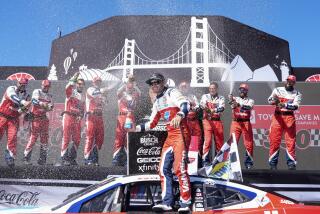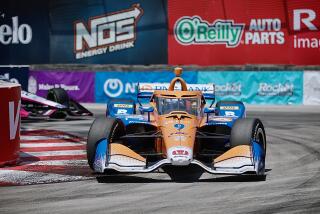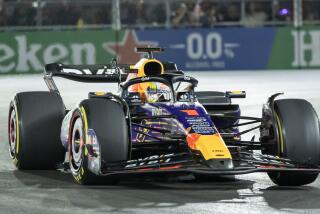MOTOR RACING USA GRAND PRIX : Senna Impressive, but Turnout Disappointing
PHOENIX — The third time did not prove to be the charm for Formula One in the Valley of the Sun.
After discouraging turnouts in 1989 and 1990 for the Iceberg USA Grand Prix, Phoenix Mayor Paul Johnson and Formula One majordomo Bernie Ecclestone forecast as many as 35,000 spectators for Sunday’s third renewal.
The crowd figure was closer to 18,500, and that estimated number included members of the 26 teams from 10 countries, concessionaires and crowd control marshals who had little to do. The mayor announced 35,000, but the grandstands, which could hold only 23,000, were barely two- thirds filled.
Predicting the outcome of the race proved much simpler.
Ayrton Senna, the world champion from Brazil and last year’s Iceberg USA winner, drove his new McLaren, with its untested Honda V-12 engine, to a wire-to-wire victory. Senna’s bitter rival, three-time world champion Alain Prost of France, finished 16.3 seconds behind in a Ferrari in the two-hour time limit race around the 2.312-mile circuit laid out in the streets of downtown Phoenix.
Senna’s mastery of the field was far more than the margin indicated. Only 10 laps before the race was called, he led Prost by 40 seconds before slowing dramatically--but not enough to keep him from having enough margin to wave to the crowd as he cruised around on his final lap.
Nelson Piquet, another three-time world champion from Brazil, finished third in a Camel Benneton Ford.
The only other driver on the same lap with Senna was Stefano Modena of Italy, in a Tyrrell Honda, and only nine of the 26 starters were running at the end. Two Japanese, Satoru Nakajima, Modena’s Tyrrell teammate; and Aguri Suzuki, in a Larrousse Lola, finished fifth and sixth to earn points in the 16-race world championship.
Senna averaged 93.018 m.p.h. for the 81-lap, 187.272 mile race--one lap short of the scheduled 82.
Despite his one-sided victory, Senna seemed unhappy with his car’s performance, even though it had never turned a wheel before arriving earlier this week. All of the team’s testing had been done with a prototype McLaren-Honda.
“We had a small problem with the gearbox, and the balance (of the car) was not quite right, which made it very difficult to keep it on the road,” Senna said.
Senna’s biggest problem, however, was in eluding team director Ron Dennis on the victory stand. Senna, in an exuberant mood, sprayed Dennis with champagne, but Dennis took the bottle way from him and chased Senna down until he poured the remaining contents over the winner’s head.
The most spectacular incident miraculously wound up with no one injured, but two cars were sorely damaged. Riccardo Patrese, who had his Williams-Renault as high as third place earlier, spun to a stop in a high-speed kink along Washington Street. Two cars narrowly missed the stalled car, but Roberto Moreno was not as fortunate. The front end of Moreno’s Benneton Ford slammed into Patrese’s front end in a shower of fiberglass. Patrese, who had been sitting in his car, jumped out and ran for the protective fence.
“I was having a good race until I came into a left-hander and there was Patrese, broadside, on the racing line,” Moreno said. “I couldn’t avoid him.”
Despite his obvious disappointment at the turnout, Ecclestone said the race would return the next two years to fulfill the five-year contract Formula One has with Phoenix.
More to Read
Go beyond the scoreboard
Get the latest on L.A.'s teams in the daily Sports Report newsletter.
You may occasionally receive promotional content from the Los Angeles Times.










